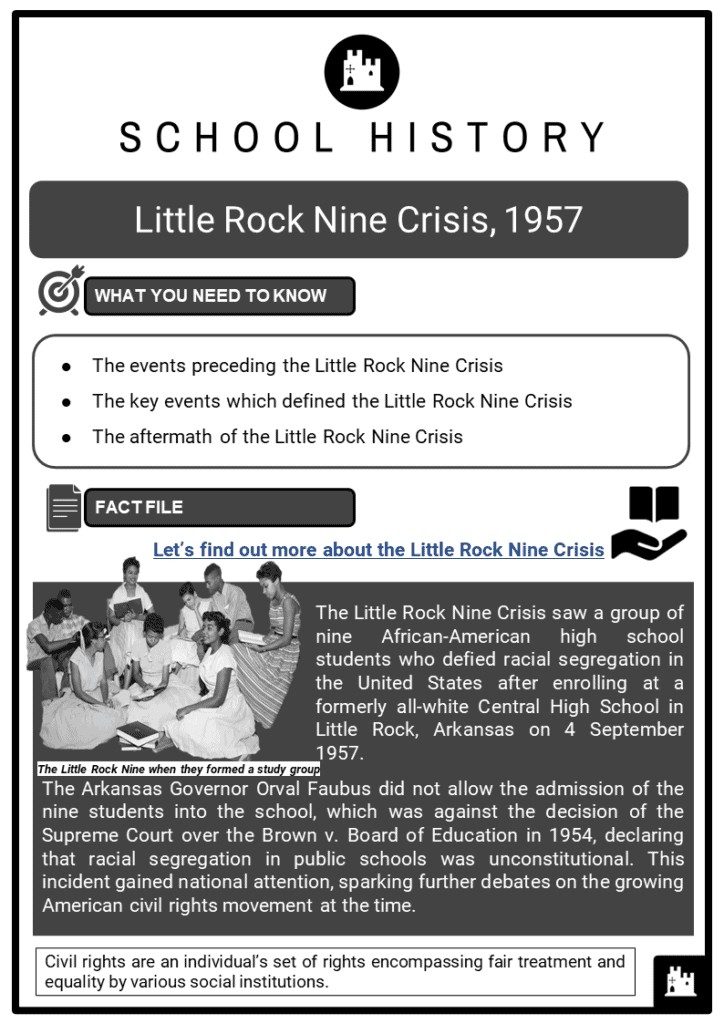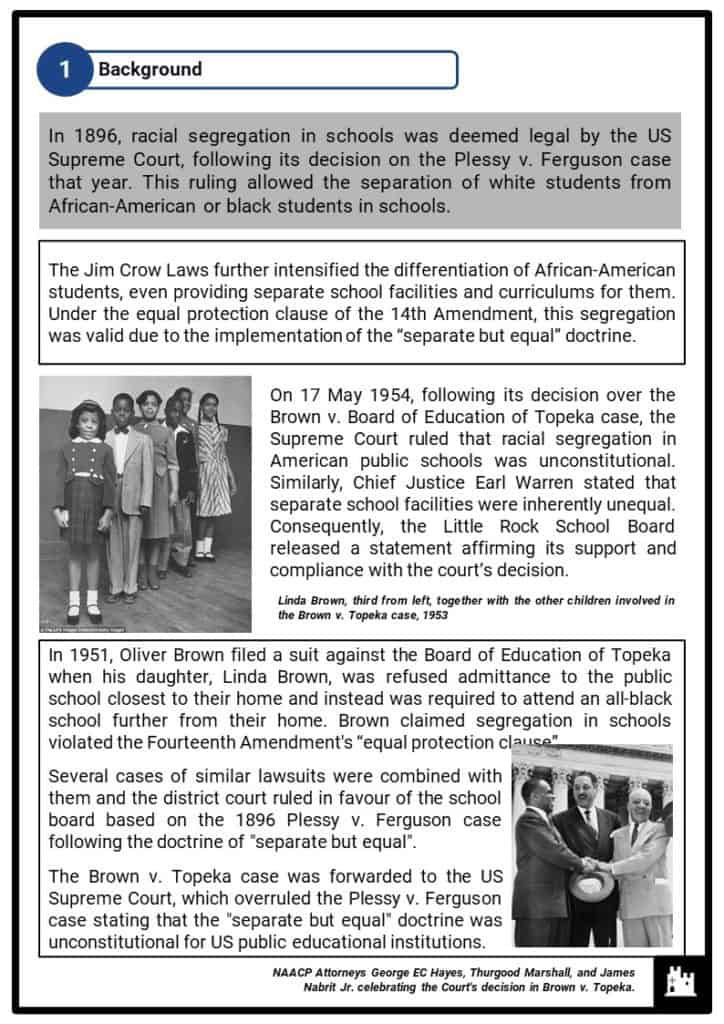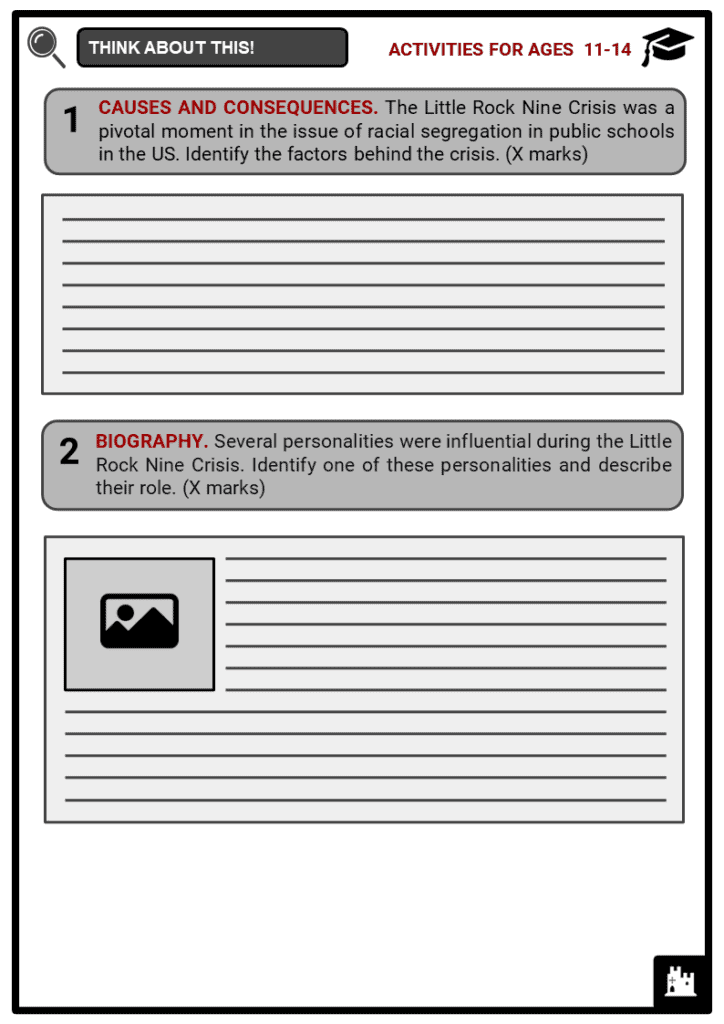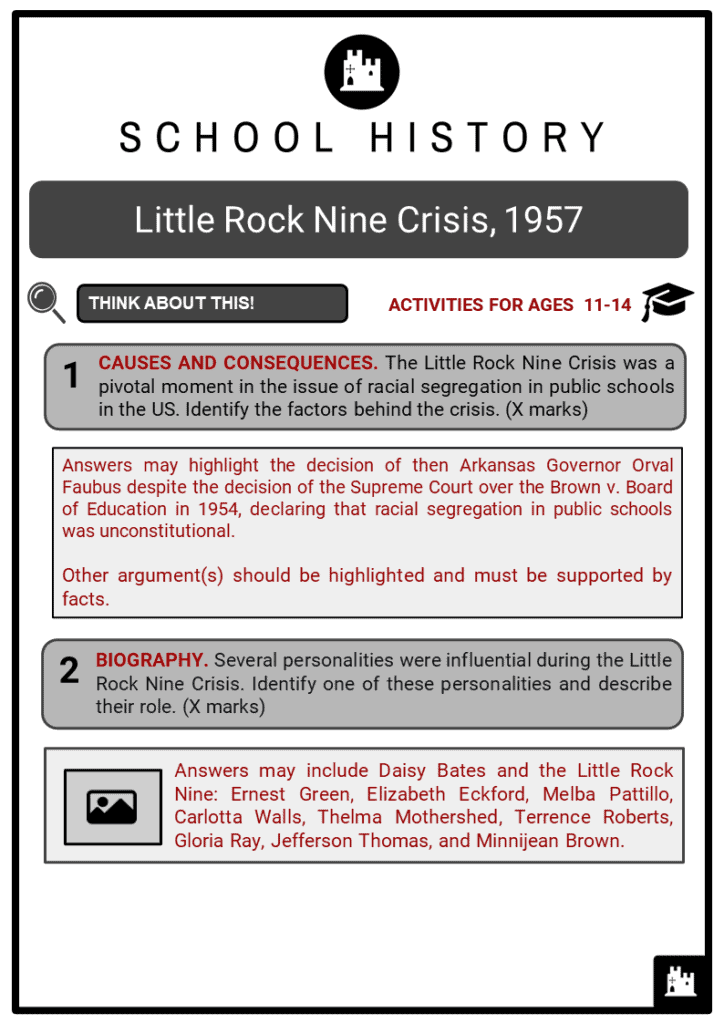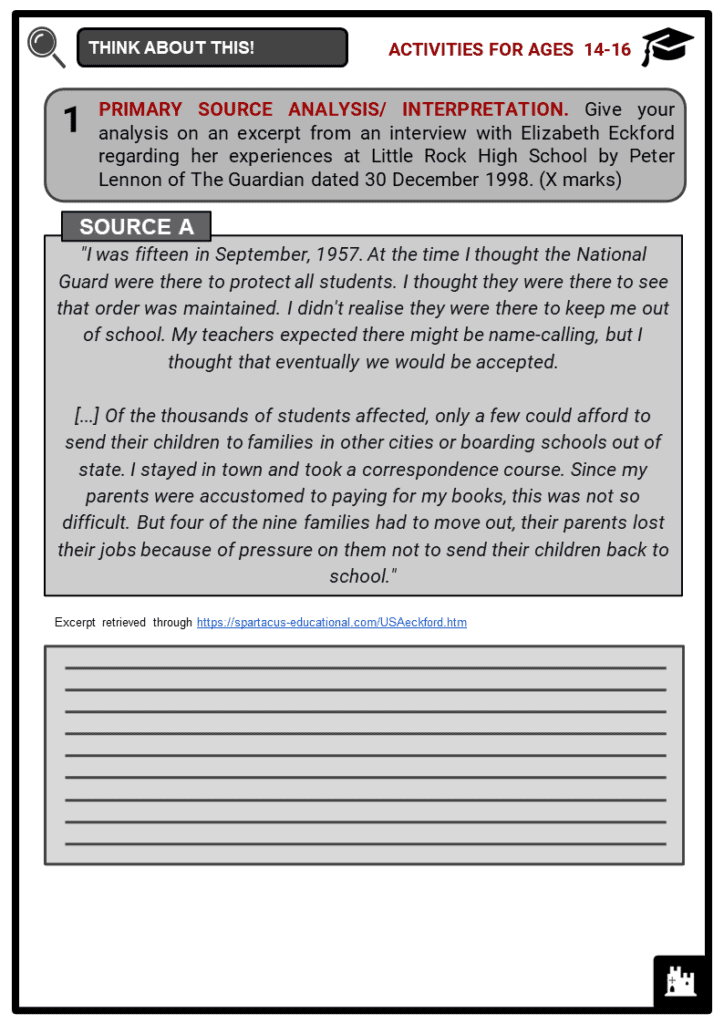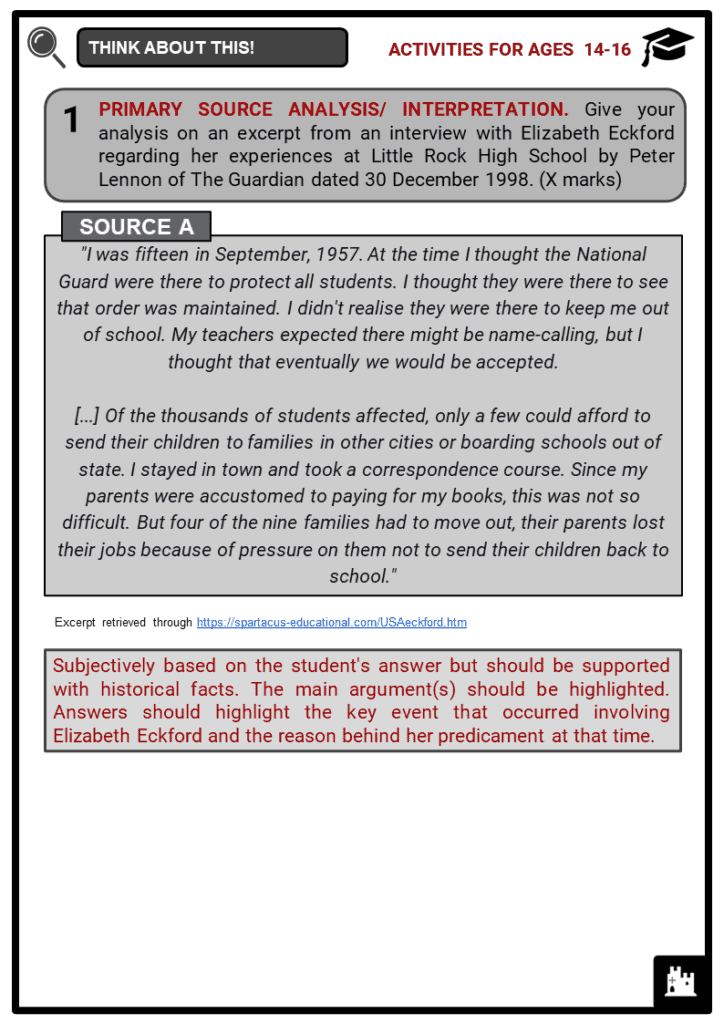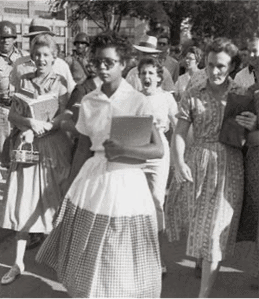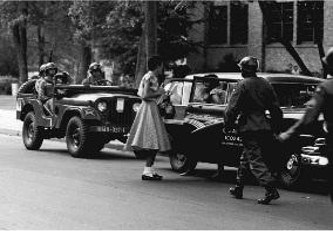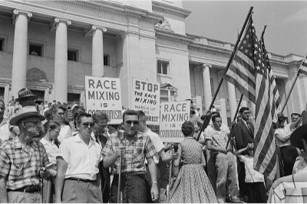Download Little Rock Nine Crisis, 1957 Worksheets
Do you want to save dozens of hours in time? Get your evenings and weekends back? Be able to teach Little Rock Nine Crisis, 1957 to your students?
Our worksheet bundle includes a fact file and printable worksheets and student activities. Perfect for both the classroom and homeschooling!
Table of Contents
Add a header to begin generating the table of contents
Summary
- The events preceding the Little Rock Nine Crisis
- The key events which defined the Little Rock Nine Crisis
- The aftermath of the Little Rock Nine Crisis
Key Facts And Information
Let’s find out more about the Little Rock Nine Crisis
- The Little Rock Nine Crisis saw a group of nine African-American high school students who defied racial segregation in the United States after enrolling at a formerly all-white Central High School in Little Rock, Arkansas on 4 September 1957.
- The Arkansas Governor Orval Faubus did not allow the admission of the nine students into the school, which was against the decision of the Supreme Court over the Brown v. Board of Education in 1954, declaring that racial segregation in public schools was unconstitutional. This incident gained national attention, sparking further debates on the growing American civil rights movement at the time.
- Civil rights are an individual’s set of rights encompassing fair treatment and equality by various social institutions.
Background
- In 1896, racial segregation in schools was deemed legal by the US Supreme Court, following its decision on the Plessy v. Ferguson case that year. This ruling allowed the separation of white students from African-American or black students in schools.
- The Jim Crow Laws further intensified the differentiation of African-American students, even providing separate school facilities and curriculums for them. Under the equal protection clause of the 14th Amendment, this segregation was valid due to the implementation of the “separate but equal” doctrine.
- On 17 May 1954, following its decision over the Brown v. Board of Education of Topeka case, the Supreme Court ruled that racial segregation in American public schools was unconstitutional. Similarly, Chief Justice Earl Warren stated that separate school facilities were inherently unequal. Consequently, the Little Rock School Board released a statement affirming its support and compliance with the court’s decision.
- In 1951, Oliver Brown filed a suit against the Board of Education of Topeka when his daughter, Linda Brown, was refused admittance to the public school closest to their home and instead was required to attend an all-black school further from their home. Brown claimed segregation in schools violated the Fourteenth Amendment's “equal protection clause”.
- Several cases of similar lawsuits were combined with them and the district court ruled in favour of the school board based on the 1896 Plessy v. Ferguson case following the doctrine of "separate but equal".
- The Brown v. Topeka case was forwarded to the US Supreme Court, which overruled the Plessy v. Ferguson case stating that the "separate but equal" doctrine was unconstitutional for US public educational institutions.
- Contrary to the Supreme Court's decision, many states refused to integrate and maintained the mandatory segregation laws of Jim Crow policies. African-American students were still not admitted to white-dominated schools, especially in the Southern States, including Arkansas, Alabama, Florida, Georgia, Kentucky, Louisiana, Mississippi, Missouri, North Carolina, Oklahoma, South Carolina, Texas and Virginia.
- On 31 May 1955, in response to this white resistance, the Supreme Court issued another ruling, known as the Brown II, mandating school districts to comply and to integrate “with all deliberate speed.”
The Little Rock Nine
- Despite the opposition of Arkansas Governor Orval Faubus, Virgil T. Blossom, who worked as the superintendent of the Little Rock School District from 1953 to 1958, proposed a plan to comply with the integration. This proposal was known as the Blossom Plan, aiming to integrate high school students, which would then be followed by lower grades.
- On 27 August 1957, the Mother’s League of Central High School held a public meeting, demanding that the implementation of integration be postponed. Two days later, Pulaski County Chancellor Murray O. Reed approved the demand, citing possible violence. However, Reed’s approval of the injunction was nullified by Federal Judge Ronald Davies, who then ordered the desegregation of public schools.
- Following this, nine African-American students enrolled at Central High. The students included Ernest Green, Elizabeth Eckford, Melba Pattillo, Carlotta Walls, Thelma Mothershed, Terrence Roberts, Gloria Ray, Jefferson Thomas, and Minnijean Brown. They were recruited for the integration by Daisy Gatson Bates, who served as the president of the NAACP in Arkansas and co-publisher of the Arkansas State Press, a known African-American newspaper.
- Later on, the group became known as the Little Rock Nine as they were at the centre of the fight against racial segregation in public schools in the United States.
- On 4 September 1957, Governor Faubus called the Arkansas National Guard to block the students’ entry into the school premises, insisting that it was for their own protection. In addition, the guards were also accompanied by white protesters, calling for the postponement of the Blossom Plan.
- During the first day of school, Elizabeth Eckford arrived at Central High alone, without knowing about the carpool plan organised by Bates because Eckford’s family also did not have a telephone. Eckford experienced extreme harassment from the guards and the crowd of white protesters, who taunted and yelled at her. She also recalled that one woman spat on her.
- This was photographed and landed on the front page of most newspapers, dubbed ‘the scream image’, which eventually drew national and international attention.
- On 20 September 1957, Federal Judge Ronald Davies issued an order removing the guards, which was soon followed by the deployment of the Little Rock Police Department to maintain peace. Moreover, President Dwight Eisenhower sent in 1,200 troops from the US Army division in Kentucky. They escorted the Little Rock Nine to attend their respective classes and remained for the rest of the year.
- Legal charges against the integration continued, as well as the harassment of the Little Rock Nine. One time, white students burned an African-American effigy on the school grounds. They were also not allowed to participate in extracurricular activities. Gloria Ray later recalled that she was pushed down the stairs. Melba Pattillo, meanwhile, had been beaten and kicked.
- In 1958, Minnijean Brown was expelled for retaliating against the attacks. Ray’s mother likewise experienced discrimination after being fired from her job at the State of Arkansas as she refused to remove her daughter from the school.
- On 25 May 1958, Ernest Green, the lone senior from the Little Rock Nine, became the first African-American graduate of Central High. The rest of the group completed their high school education in other schools across the country.
- By September 1958, marking one year after the integration, Governor Faubus ordered the closing of all high schools in Little Rock, after conducting public voting against the integration with 19,470 votes against 7,561.
Aftermath
- By 1959, the Supreme Court ordered the reopening of all schools in Little Rock and the implementation of the desegregation.
- Most of the Little Rock Nine had successful careers.
- Ernest Green became the assistant secretary for the federal Department of Labor during the term of President Jimmy Carter.
- Melba Pattillo became a well-known NBC journalist. Elizabeth Eckford joined the Army. Later on, she received her General Education Equivalency diploma.
- Meanwhile, Minnijean Brown served as the deputy assistant secretary in the Department of the Interior under President Bill Clinton. Terrence Roberts finished his PhD and became a UCLA professor.
- Jefferson Thomas also served for the Army in Vietnam, completed a business degree, and worked as an accountant for the Pentagon and for private companies. Unfortunately, he died of pancreatic cancer on 5 September 2010.
- Due to their contribution to the American civil rights movement, President Clinton awarded the Little Rock Nine the Congressional Gold Medal. They were also invited by President Barack Obama to his inauguration in 2009.
Image sources:

